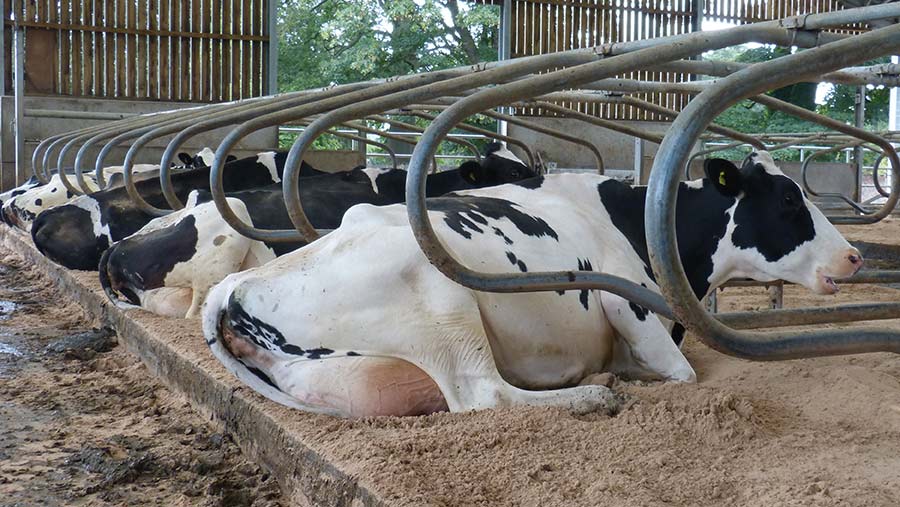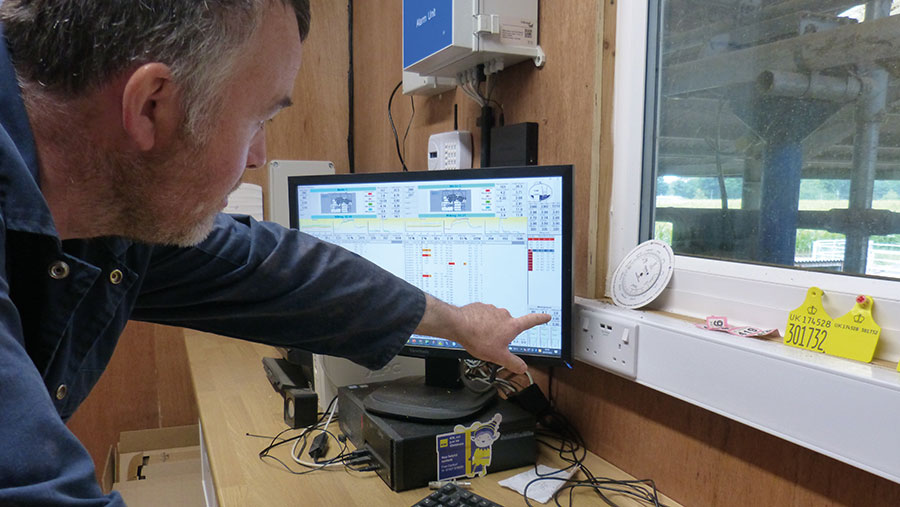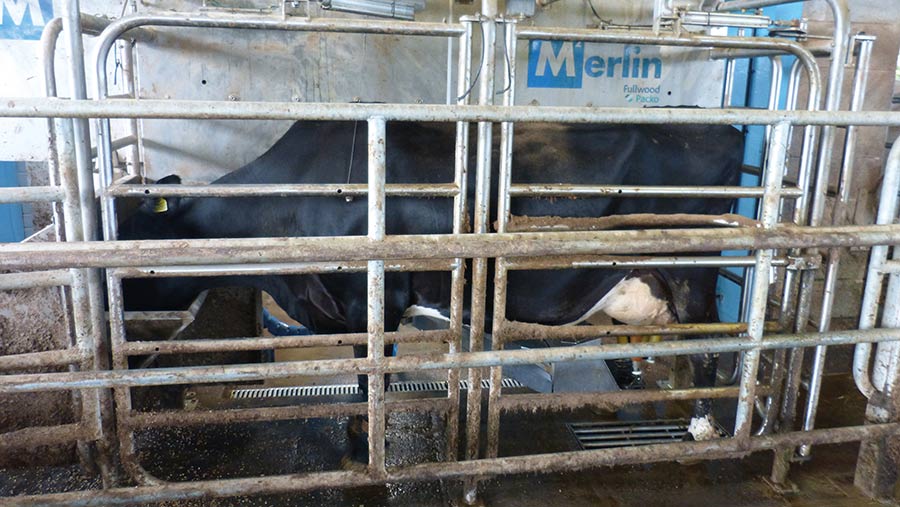How Staffs dairy gets high robot visits with low cake costs
 © MAG/Michael Priestley
© MAG/Michael Priestley A Staffordshire robot dairy averages 3.7 robot milkings from 4.7 visits a day and has cut manufactured feed use to an average of 1.9kg a cow.
Matt Weaver, of Aston Pool Farm, near Stone, is minimising expensive bought-in parlour nut requirements while maintaining production and milking frequency.
He was feeding 4kg of nuts and 3kg of home-grown rolled barley at peak lactation. Now a maximum of 2.5kg of nut is fed, with no drop in visits or milk yield.
See also: How an Irish farmer combines grazing with milking robots
Farm facts: Aston Pool Farm
- 115 Holsteins and Brown Swiss cross all-year-round calving herd
- Milk sold to Yew Tree dairy on a solids-based contract
- 11,021 litres of milk sold a cow at 3.69% fat and 3.14% protein
- 54,000 somatic cell count
- 254ha (630 acres)
- 43.8ha (108 acres) grazing for heifers and dry cows
- 49ha (121 acres) of silage ground
- 13.2ha (32.6 acres) of maize
- 108ha (267 acres) in wheat, winter barley, spring oats or beans this year
- Rest is forage sales
Feed is allocated by a simple stepped flat-rate approach based on days in milk (see “Table 1”) in the robot.
Mr Weaver says he would probably not be dairying without robots, but was not prepared to feed 10kg a cow a day of expensive cake in the robots to ensure a high number of daily visits.

Matt Weaver in his farm office © MAG/Michael Priestley
Farm performance for the year to June 2022 shows margin over all feed (MOF) of 19.33p/litre, with a 31.9p/litre average milk price.
Table 1: How much feed cows get daily in the robots in addition to total mixed ration |
||||||||
|
Days in milk |
0-13 |
14 |
15 |
100 |
120 |
200 |
250 |
250+ |
|
Bespoke parlour cake (kg/day) |
2 |
2.5 |
2.5 |
2.5 |
2 |
2 |
1.5 |
1.5 |
|
Home-grown rolled barley (kg/day) |
1.5 |
4 |
4 |
4 |
3 |
1.5 |
1.5 |
1 |
|
Monopropylene glycol (g/day) |
350 |
350 |
– |
– |
– |
– |
– |
– |
System change
Historically, Mr Weaver ran 300 cows with 280 in milk through a 24:48 Gascoigne parlour, which was discontinued. The old parlour is now being converted into three residential properties.
All milkers and in-calf cows and heifers were sold from September that year, which funded two Fullwood robots in a remodelled cubicle shed.
Mr Weaver retained the young heifers and calved them down to milk through the robots, which were installed in December 2019.
He says 95-100 cows in milk is about perfect for two robots. “When we have 90 in milk, we run at 3.8-4 milkings a cow a day. Any more than 100 means numbers of milkings and yield is compromised.
“It’s difficult to say by exactly how much, and, of course, the current milk price is helping, but profit a cow is greater than when the herd size was double what it is now,” he says.
Robot visits

Fullwood robot © MAG/Michael Priestley
A high-quality bespoke dairy nut is fed through the robots to ensure frequent visits. Wheat feed and sugar beet inclusion are low and only used for nut integrity.
“I can provide digestible fibre myself from home-grown forage and arable crops, so digestible ingredients that are often used as fillers in manufactured nuts are minimised,” says Mr Weaver.
High starch and sugar components help palatability. Generally, very few cows need fetching to the robot, with 2.5 days without retrieving any cows being the farm’s current record. Cows are only brought to the robot if they haven’t been milked for 12 hours.
Home-grown feed
With less reliance on robot cake, the total mixed ration (TMR) is relied upon to provide a balanced and cost-effective diet using home-grown cereal (see “Table 2”). Iwan Vaughan of Dairy Diagnosis does the ration.
Early this summer, home-grown cereal, alkalage and grass silage amounted to about 20kg of dry matter (DM) in the TMR diet, of which 8.4kg was grass silage.
Table 2: The total mixed milker ration at Aston Pool in August 2022 |
||
|
Feed |
DM kg a cow a day |
Freshweight (kg) |
|
Wheat alkalage |
4.8 |
6 |
|
Ground barley (robot fed) |
3.52 |
4 |
|
June 2022 fourth cut grass silage |
8.4 |
25 |
|
Dairy nut (robot fed) |
2.21 |
2.5 |
|
Molasses cane |
1.46 |
2 |
|
Rolled wheat |
3.01 |
3.5 |
|
Rapeseed meal (protected) |
2.679 |
3 |
|
Rumen protected methionine |
0.02 |
0.02 |
|
Mineral |
0.19 |
0.2 |
Achieving high daily visits
Mr Weaver suggests the following additional ways to achieve a high frequency of daily visits to the robots.
Cow flow
- Get independent advice The farm called on the advice of Ivor Davey of Cow Plan and visited several robot farms to learn from others.
- Space is key The shed has 126 feed spaces and 112 cubicles for 95-100 cows.
- Make the robot attractive Both robots have a foot-bath, a drinker opposite, a slatted floor around the outside of the robot as cows defecate after milking, and a feed station in the robot.
- Key figures The shed has two double rows of cubicles with 5.27m of feeding room on the outside and ends of the cubicles at the feed face, and 4.45m of space in the centre passageway.
Managing lameness
- Make foot-bathing easy An automated foot-bath with a 4% formalin solution has helped eliminate digital dermatitis (DD). This was used five days a week and now just three days a week (Monday, Wednesday and Friday). Both robots have a foot-bath, and on foot-bath days cows walk through it 4.7 times a day, on average.
- Three foot checks each lactation Routine checks are carried out at 100 days-in-milk, 200 days-in-milk and again just before dry off.
- Key figures Eliminating DD has helped limit cull rate to just 14-15%, down from 22-24%, meaning surplus heifers can be sold.
Cow comfort
- Fresh air Three sides of the shed are open, with the gable end covered by a brick wall housing the farm office.
- Hygiene Sand bedding has helped the robotic system minimise somatic cell count and mastitis. Sand is cleaned and raked twice daily and new sand is added weekly. A scraper tractor, which will be replaced by a slurry-collecting robot this year, cleans the building twice a day.
- Key figures Cell counts are averaging about 54,000 cells/ml – previously they were between 120,000 and 150,000. About 20% of cows receive antibiotic dry cow tubes. The farm used to have 24 mastitis cases for every 100 cows, but has only had three clinical cases since 2019.
Transition management
By paying close attention to management at transition, Mr Weaver has improved further areas of herd performance.
A ruminal bolus is used to modify rumen function, increase glucose production and lower ketosis rates. A monopropylene glycol supplement is given through the robots to fresh cows, and a reviver drink is given to cows after calving.
As a result, clinical cases of ketosis have been eradicated. This has helped lift pregnancy rate from 18-19% to 25%, and conception rate from 32% to 38%.
Cull rates are at 14-15%, meaning extra income from heifer sales.
The numbers
- 23.105 Margin over purchased feed (p/litre) for the year up to June 2022 (milk price average 31.9p/litre)
- £2,541.55 Margin over purchased feed a cow
- 37.5kg How much milk cows yield daily on average
- £4,900 Recent price for a genomically tested six-month-old heifer calf at Carlisle bred by Matt Weaver’s son, Dan, and DW Genetics
